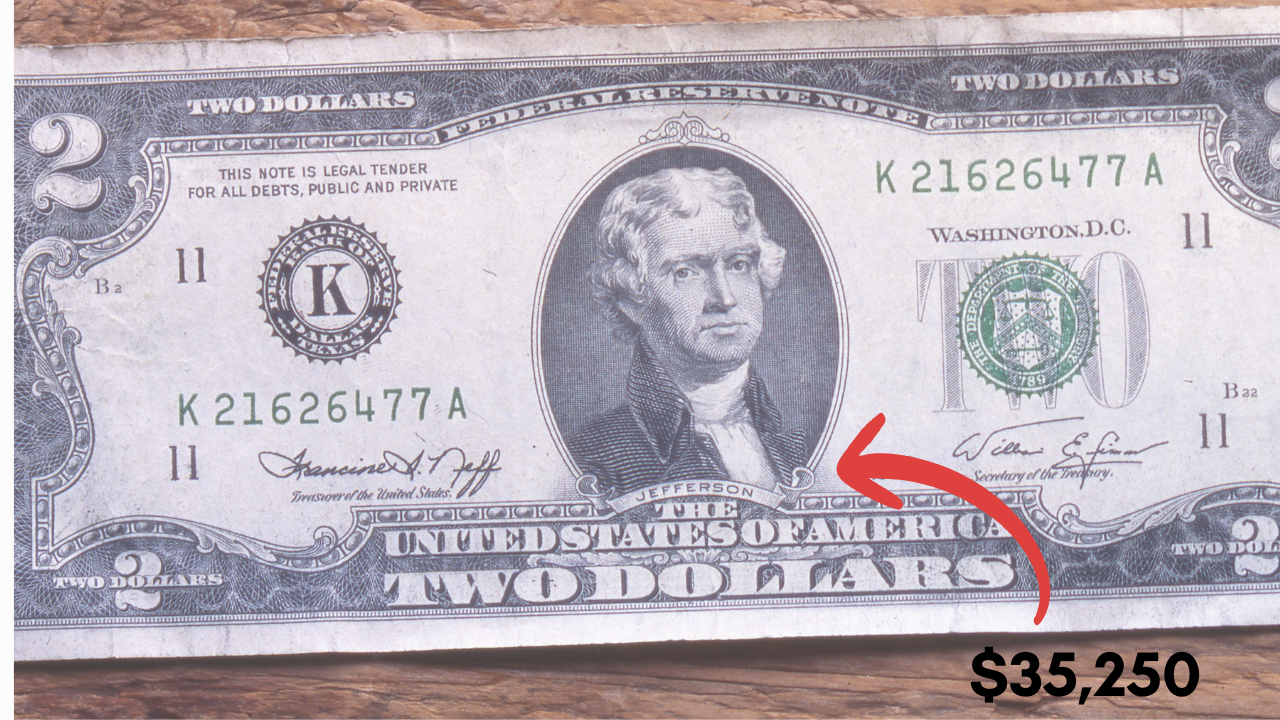Coin and forex gathering is complete of surprises—and one of the modern-day testimonies proves it. A 1976 $2 invoice currently offered for an astounding $35,250 at auction. While most $2 payments continue to be not unusual place and nevertheless flow into today, some specific versions with unique traits may be really well worth thousands.
For many American collectors, this sale serves as a reminder to test vintage stashes of cash tucked away in drawers, picturegraph albums, or inherited collections. Below, we’ll discover what made this $2 invoice so rare, why it commanded one of these excessive price, and the way you may decide whether or not your payments might also additionally maintain hidden value.
Why the 1976 $2 Bill Holds Value
Several elements decide whether or not a 1976 $2 invoice is really well worth most effective face value—or thousands:
- Printing Errors – Inverted seals, double printing, or misaligned serial numbers make a invoice rare.
- Serial Numbers – Collectors prize low numbers (like 00000001), famous person notes, or patterned sequences along with 12345678.
- Uncirculated Condition – Notes with crisp texture, sharp corners, and no folds fetch top class prices.
The invoice that these days bought mixed all of those traits, explaining its extraordinary $35,250 hammer price.
Historical Importance of the 1976 $2 Bill
The 1976 $2 invoice became reissued to commemorate America’s Bicentennial. It functions Thomas Jefferson at the the front and the signing of the Declaration of Independence at the reverse.
Although billions have been printed, incredibly few live to tell the tale in flawless, uncirculated condition. Its symbolic connection to U.S. records makes it particularly perfect to collectors. Owning one looks like preserving a slice of American heritage, which fuels call for in the market.
Also read: Drivers Warned – £300 Fines And 11 Points For Highway Code Breach September
Auction Spotlight: The $35,250 Sale
During the auction, fierce bidding drove the cost of this uncommon word to $35,250. Its standout functions included:
- A acceptable serial number
- Uncirculated condition
- Printing errors
These mixed traits set it other than fashionable issues, developing excessive opposition and a record-breaking price.
Features That Make a 1976 $2 Bill Rare
Not each 1976 $2 invoice is valuable. The following developments considerably improve a note’s worth:
- Fancy Serial Numbers – Low digits, repeating patterns, or famous person notes
- Printing Errors – Doubled numbers, lacking ink, or misaligned seals
- Uncirculated State – Crisp, fold-unfastened payments with sharp edges
- Limited Runs – Notes issued through sure Federal Reserve Banks are scarcer
- Historical Significance – Bicentennial symbolism provides appeal
| Condition / Feature | Estimated Value Range |
|---|---|
| Regular circulated note | $2 – $5 |
| Crisp uncirculated | $15 – $50 |
| Fancy serial number | $100 – $2,000 |
| Major printing error | $5,000 – $25,000 |
| Rare combo (like auction bill) | $35,000+ |
How to Tell If Your 1976 $2 Bill Is Valuable
If you personal a 1976 $2 invoice, observe those steps to test its capacity worth:
- Inspect the condition – Crispness, no wear, and sharp corners upload value.
- Check the serial number – Look for big name notes or fancy sequences.
- Look for errors – Misaligned seals, ink issues, or printing anomalies.
- Verify the Federal Reserve Bank – Some banks revealed fewer payments, making the ones notes rarer.
- Compare with public sale records – See how comparable payments have sold.
If your invoice meets those criteria, recall having it professionally graded or appraised.
Rising Interest in Collectible Currency
The $35,250 sale highlights a developing fashion in the collectible foreign money market. Younger creditors are an increasing number of interested in bodily cash, especially notes connected to iconic occasions which include the Bicentennial.
Online structures and essential public sale homes are seeing better opposition for uncommon payments, riding fees upward. This surge in call for encourages Americans to take a 2d examine cash tucked away at home.
Investment Opportunity in Rare Bills
Rare foreign money isn’t pretty much history—it may additionally be a worthwhile investment. The $35,250 1976 $2 invoice illustrates how dramatically values can rise. Unlike stocks, uncommon payments are tangible property with cultural and anciental significance, making them attractive to investors.
Experts agree with call for for collectible foreign money will maintain to grow, that means undervalued notes these days may want to grow to be tomorrow’s treasures.
The sale of a 1976 $2 invoice for $35,250 has reignited hobby in collectible U.S. foreign money. While most $2 payments are handiest really well worth face value, people with specific features—consisting of uncommon serial numbers, printing errors, or pristine condition—can deliver in thousands. For creditors and buyers alike, this occasion underscores the significance of cautiously checking antique payments. With growing call for and constrained supply, the marketplace for uncommon American foreign money suggests no signal of slowing down.
FAQs
Q1. Are all 1976 $2 payments treasured?
No. Most are most effective really well worth face value ($2). Only payments with uncommon features—inclusive of fancy serial numbers, printing errors, or uncirculated condition—deliver considerable value.
Q2. How can I inform if my 1976 $2 invoice is uncommon?
Check the condition, examine the serial quantity, and look at for printing errors. Crisp, uncirculated notes with big name notes or uncommon quantity sequences are maximum sought after.
Q3. What does “big name be aware” mean?
A big name be aware replaces a invoice with a printing mistakess at some stage in production. These are a good deal scarcer than popular issues, making them extra treasured to collectors.
Q4. Where can I promote a treasured $2 invoice?
Rare payments are first-class offered via expert public sale houses, foreign money dealers, or relied on on-line collectible marketplaces.
Q5. Why turned into the $2 invoice reissued in 1976?
It turned into reintroduced to commemorate America’s Bicentennial, presenting Thomas Jefferson at the the front and the signing of the Declaration of Independence at the back.
